Frank's travels around Britain 2011.
The Welsh Borders.
Start with a big breakfast
We didn't go straight to the Welsh borders immediately. We had Uncle Brian with us & we began our journey with a hearty breakfast at a Crown Carvery. Our nearest is at The Game Cock, 8 Whalley Road, Great Harwood, Blackburn. BB6 7UH. We discovered them after eating their magnificent £3.69 three meat carvery. Good food, huge portions & tastes great! Their breakfast is just as stunning. You get two rashers of bacon, a huge sausage & then it's all you can eat of fried and scrambled eggs, mushrooms, tomatoes, hash browns and baked beans. It's well cooked & a tasty belly buster! We were to take Brian to stay with Cynthia's family on the Sunday & on the Monday we were to see our friends and most enjoyable it all was too! Mum & dad were lovely hosts as usual (as I'm now an orphan, I have adopted them) & she treated us to an outstanding chicken casserole recipe from Catalonia. As it was a belated Fathers day, we treated Phillip to some of his favourite "medicine" and that brought a smile to his face.
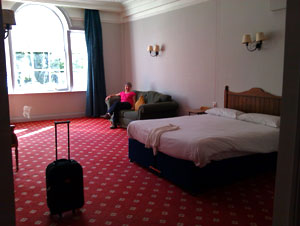 Kingswinford
Kingswinford
That evening we experienced the difference that you get from one Travelodge to another. The Kingswinford Travelodge was an old house that became an hotel & then a Travelodge. It's only been open for less than a year. The receptionist was very friendly as usual and asked which floor we would like. Due to my breathless condition, we opted for the ground floor. Most apologetically, she could only offer us the disabled room .... Take a tip, ASK for room 108, its fantastic. It's huge, even the bed has a much better mattress than your normal Travelodge! We had had such a big meal, courtesy of mum, that we just had Tesco sandwiches & fruit in our room, it was all very pleasant.
In the small shopping centre in Kingswinford, there is a really nice
cafe. Not the cheapest but so welcoming that we always have our breakfast there.
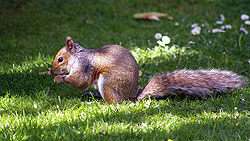 Try Jilly's Coffee Shop, 8 Townsend Place, for the satnavs amongst you, it's
DY6 9JL. Good food, freshly prepared & a set of ladies who seem to enjoy
working there. As an aside, this is where you can hear some glorious Black
Country accents surrounding you. It's an eavesdroppers paradise!
Try Jilly's Coffee Shop, 8 Townsend Place, for the satnavs amongst you, it's
DY6 9JL. Good food, freshly prepared & a set of ladies who seem to enjoy
working there. As an aside, this is where you can hear some glorious Black
Country accents surrounding you. It's an eavesdroppers paradise!
After an excellent breakfast we went off to see our best friends, Kath & Dave. They were over the moon with some help we had given them on their family tree.
All you need are appreciative friends, home made cake & a morning sitting in their garden watching their wildlife. It was a joy!
Oswestry
We had based ourselves in the Oswestry Travelodge only because it was central & VERY inexpensive. It's a good location but a very sad place in need of a complete refit. Stains on the dressing table, a shower that gave up on the second day & the usual poor mattress. Another tip. Ask for a spare duvet, they always have plenty of single ones spare. It will cushion you from those dreadful springs that poke through. It works for Cynthia anyway.
Once again we needed somewhere for breakfast. The Little Chef people have priced themselves out of the market, in our opinion, so we used the new all singing, all dancing Smart phone (known as Gladys) to locate a superstore with a cafe. This must be an isolated area for them, as the only one that came up was Stan's Superstore ... a full English for £1.99 .... no, we were very wary too! Oh how wrong can you be! Situated in the middle of nowhere this is a very attractive outlet. It's claim to fame is that it's the largest family run, independent, single outlet superstore in the country. It's got a great website, full of information & if anyone tries harder, I'd like to visit them too. The cafe is as smart as anywhere we've visited, the staff as lovely & friendly & the food is outstanding! Freshly cooked & good quality & quantity. Their bacon is great, fresh orange is delicious but their coffee was truly dreadful! The girls struggled mastering a new till with a smile, & we ate there on both days. We heartily recommend you search out this place. Stan's Superstore, St. Martins, Oswestry, Shropshire SY11 3AY.
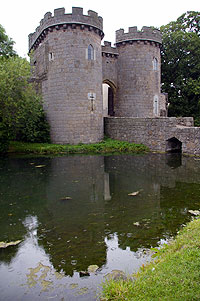 Oswestry is best described as OK. Maybe it was the rain, maybe it was
overshadowed by nicer places, but we sure didn't stay there long.
Oswestry is best described as OK. Maybe it was the rain, maybe it was
overshadowed by nicer places, but we sure didn't stay there long.
Just down the road is Whittington Castle. Even though it said it was closed, don't let that put you off. Free & with access to the castle & car park, its definitely worth seeing. As their website says, All Whittingtons in the UK would claim Richard Whittington, Mayor of London, as their most famous son. However similarities between Dick Whittington's coat of arms to those of Fulk Fitzwarine (who was largely responsible for the building of Whittington Castle) may not be pure coincidence, and the cottage where he reputedly lived is not far from the Castle. With the A5 passing right in front of the Castle gates it seems entirely reasonable that Dick set out along this ancient route to London to seek his fortune. It certainly has had a turbulent history through its many years & its legends are no less interesting, How about the Holy Grail, Robin Hood & the Babes in the Wood story!!!
The castle was originally a motte-and-bailey castle, but this was replaced in the 13th century by one with buildings around a courtyard whose exterior wall was the curtain wall of the inner bailey. As a castle of the Welsh Marches, it was built on the border of Wales and England, very close to the historic fort of Old Oswestry. Whittington lies on the English side of Offa's Dyke, which in this area was the Norman boundary between England and Wales. The castle of Whittington may have begun as a Norman manor house, although there is no evidence for this. The site was fortified as a castle for William Peverel, in 1138, in support of Empress Matilda, the daughter of Henry I & King Stephen, nephew of King Henry I, and claimant to the throne during The Anarchy. Whittington Castle is unique in that it is the only castle in the UK which is owned and managed by a community of local residents.
Llangollen
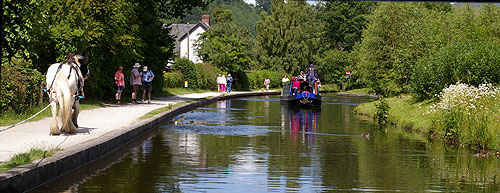 The next day, after our visit to Stan's,
we started the day in the
delightful Llangollen. A town of steam trains & horse drawn barges. Its
glorious River Dee cuts across the town & is great for photographs.
The next day, after our visit to Stan's,
we started the day in the
delightful Llangollen. A town of steam trains & horse drawn barges. Its
glorious River Dee cuts across the town & is great for photographs.
Torn between a train trip or a canal barge, the 45 minute, horse drawn barge won out. Just a delight. Gentle horses, stunning scenery & the utter peace was just what the doctor ordered.
Work commenced on the canal in this area in 1795, but the canal was never finished as intended, and the central section was only built from Trevor Basin to Weston Lullingfields via Lower Frankton. Instead the centre section was extended westwards from Trevor, through Llangollen to Horseshoe Falls, a weir on the River Dee, as a navigable feeder. The canal was extended also eastwards from Frankton Junction at Ellesmere via Whitchurch to Hurleston Junction near Nantwich, on the then rival Chester Canal. The Ellesmere Canal eventually became part of the Shropshire Union Canal network, in 1846.
Llangollen takes its name from Saint Collen (from the Welsh llan meaning 'fortified church yard' and gollen meaning Collen), a 6th century monk who founded a church beside the river there. St Collen is said to have arrived in Llangollen by coracle. As there are no other churches in Wales dedicated to St. Collen, it is possible that this St. Collen may also have connections in both Colan Cornwall and Langolen Brittany.The town has so many places to visit. Standing high above the town to the north is Castell Dinas Bran, the former stronghold of the Princes of Powys. Beyond the castle is the limestone escarpment known as the Eglwyseg Rocks. The outcrop continues north to the area known as World's End. The area nearest to the castle is the Panorama Walk, and a monument to local poet I.D. Hooson (from the nearby village of Rhosllanerchrugog) can be found there.
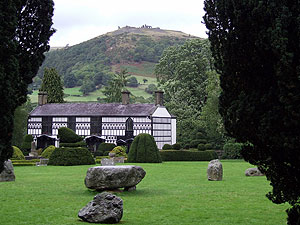 Valle Crucis
Abbey was established in nearby Llangwestl in
about 1201, under the patronage of Madog
ap Gruffydd Maelor of Castell
Dinas Brân. The bridge at Llangollen was built in about 1345 by John
Trevor, of nearby Trevor Hall, who later became Bishop
of St Asaph. It was extended to cross the railway when this was built in
the 1860s and was widened in the early 1960s. The upstream side has new
masonry which blends in with the older structure.
Valle Crucis
Abbey was established in nearby Llangwestl in
about 1201, under the patronage of Madog
ap Gruffydd Maelor of Castell
Dinas Brân. The bridge at Llangollen was built in about 1345 by John
Trevor, of nearby Trevor Hall, who later became Bishop
of St Asaph. It was extended to cross the railway when this was built in
the 1860s and was widened in the early 1960s. The upstream side has new
masonry which blends in with the older structure.
On the outskirts of the
town is Plas
Newydd ("New Place" or "New Hall"), where The Honourable Sarah Ponsonby
and Lady Eleanor Butler (the Ladies
of Llangollen) lived. They were quite a fascinating pair & I'm sorry we didn't fit their
house
in. In April 2011, the same month in which the first Irish civil
partnerships took place under the Civil
Partnership and Certain Rights and Obligations of Cohabitants Act 2010,
Irish state broadcaster RTE broadcast
a 45 minute radio documentary about the lives of Eleanor Butler and Sarah
Ponsonby entitled "An Extraordinary Affair". It posed the question of
whether they could, in fact, be considered Ireland’s first openly lesbian
couple. Although we didn't go there, I have included their interesting
website.
Erddig
If you're in this area, don't miss this interesting house. I wonder if it is unique in showing so much of the photographs & lives of the servants. Many National Trust properties are full of the important rich "Upstairs" owners & their famous visitors. This place starts with the "Downstairs" folk in such detail. It tells of the Yorke family's unusually high regard for their servants through a collection of portraits, photographs and verses, a family tradition started by Simon's son Philip Yorke (1743-1804). Now they weren't Willy Shakespeare nor Willy Wordsworth but they are obviously written with such love. I remember one dairy girl who was very good but couldn't make cheese! It all grabs your attention & you should allow a long time because its very difficult not to read every one.
 Erddig was built in 1684–1687 for Joshua
Edisbury, the high
sheriff of Denbighshire and
was designed by Thomas
Webb. It is one of the country's finest stately
homes - in September 2007 it was voted the UK's "favourite Historic
House" and the "8th most popular historic site" in the UK by Britain's
Best. In 2003 it was voted by readers of the Radio
Times and viewers of the Channel
5 television series "Britain's Finest Stately Homes" as "Britain's
second finest"
Erddig was built in 1684–1687 for Joshua
Edisbury, the high
sheriff of Denbighshire and
was designed by Thomas
Webb. It is one of the country's finest stately
homes - in September 2007 it was voted the UK's "favourite Historic
House" and the "8th most popular historic site" in the UK by Britain's
Best. In 2003 it was voted by readers of the Radio
Times and viewers of the Channel
5 television series "Britain's Finest Stately Homes" as "Britain's
second finest"
The building was sold to the master
of the Chancery, John
Meller in 1714. John Meller refurbished and enlarged the house
(including adding two wings in the 1720s), and, on his death in 1733
unmarried and childless, passed it to his nephew, Simon
Yorke, (d.1767) first cousin of Philip
Yorke, 1st Earl of Hardwicke. The house was passed down through the Yorke family
until March 1973, when it was given to the National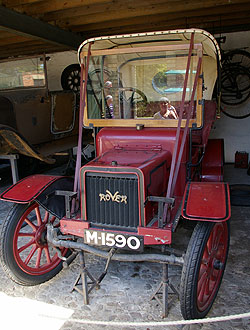 Trust. This followed the collapse, several years earlier, of
the nearby coal mine, (Bersham
colliery) under the house, causing subsidence of
5 feet (1.5m), which seriously affected the structural security of the
house to the extent that, without suitable underpinning, it would have
become a ruin. It was strengthened using the compensation of £120,000 the
National Trust was able to extract from the National
Coal Board. 63 acres (250,000 m2) of Erddig Park (out of view of the
house) was subsequently sold for £995,000 and this paid for the restoration
work on the house. The restoration was completed on 27 June 1977 when Charles,
Prince of Wales, officially opened Erddig to the public, joking that it
was the first time in his, albeit short, life that he had opened something
that was already 300 years old.
Trust. This followed the collapse, several years earlier, of
the nearby coal mine, (Bersham
colliery) under the house, causing subsidence of
5 feet (1.5m), which seriously affected the structural security of the
house to the extent that, without suitable underpinning, it would have
become a ruin. It was strengthened using the compensation of £120,000 the
National Trust was able to extract from the National
Coal Board. 63 acres (250,000 m2) of Erddig Park (out of view of the
house) was subsequently sold for £995,000 and this paid for the restoration
work on the house. The restoration was completed on 27 June 1977 when Charles,
Prince of Wales, officially opened Erddig to the public, joking that it
was the first time in his, albeit short, life that he had opened something
that was already 300 years old.
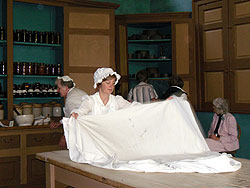 The first things you see as you enter are the estate buildings including
the joiners' shop and smithy (where
the joiner and blacksmith worked),
the Midden Yard (with its
saw mill and cart sheds), and the Stable Yard (with its stables
and tack room, carriages, vintage bicycles and vintage
cars). The tour of the house begins with the laundry, bakehouse, kitchen
and scullery.
The first things you see as you enter are the estate buildings including
the joiners' shop and smithy (where
the joiner and blacksmith worked),
the Midden Yard (with its
saw mill and cart sheds), and the Stable Yard (with its stables
and tack room, carriages, vintage bicycles and vintage
cars). The tour of the house begins with the laundry, bakehouse, kitchen
and scullery.
The
nearby river supplied a
source of water, and it was pumped uphill by a self running hydraulic
ram, which utilised falling water to power itself, and pump the drinking
water uphill to the house.
Whilst occupied by the Yorke family the
house was never installed with mains
electricity, with the last Squire, Philip, relying on a portable
generator to power his single television set. The saw mill, however, was
equipped with its own static steam
engine to provide the power for sawing and turning.
Of course, I ran out of puff after some hours of wandering round. It was a pity for Cynthia as we missed the top floor of a house, once again. I had a rest in the garden while she walked around taking more photographs.
Chester
We had our final breakfast at Stan's before setting off for Chester. We still had time to look for a decent cup of coffee, that Wales in general, had denied us. Plus we would have time for a walk around the Roman Walls, as it was always a thing Cynthia wanted to do since her first visit to Chester. I want Cynthia to give her impression of a city she really likes.
As Frank had to be back for a blood test at the hospital later that afternoon, it seemed an ideal opportunity to stop off at Chester on our return journey. I'd only visited the city once before, while en route to North Wales, and was only too happy to return. I think it's probably up there amongst my favourite cities in the country. It's a shoppers paradise, while at the same time being full of history, as well as having a warm welcoming buzz.
Being chauffeured by an ex rep is a huge advantage when it comes to
finding places to park. Frank seems to know every town and city like
the back of his hand, and he soon found us a car park right next to the city
walls. (However he's still recovering from the shock of what it
cost...£9.80 for 3 hours!!!!)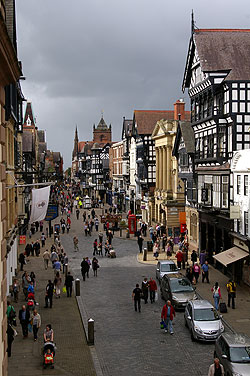
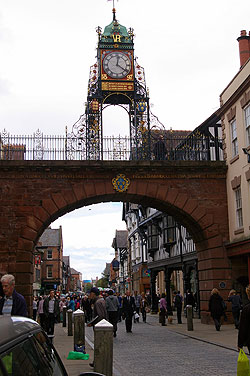 The
early rain had passed and we set off along the walls. I believe that Chester
is the only city in the UK that still has it's city
walls complete and well preserved. I was
a little concerned at first as we seemed to encounter several flights of
steps, which would make Frank very breathless, but it soon evened out to make
an easy, pleasant walk.
The
early rain had passed and we set off along the walls. I believe that Chester
is the only city in the UK that still has it's city
walls complete and well preserved. I was
a little concerned at first as we seemed to encounter several flights of
steps, which would make Frank very breathless, but it soon evened out to make
an easy, pleasant walk.
Within minutes we came to the Eastgate Clock, which is particularly attractive. It stands on the site of the original entrance to the Roman fortress of Deva Victrix. It is a prominent landmark in the city of Chester and is said to be the most photographed clock in England after Big Ben. The original gate was guarded by a timber tower which was replaced by a stone tower in the 2nd century, and this in turn was replaced probably in the 14th century. The present gateway dates from 1768 and is a three-arched sandstone structure which carries the walkway forming part of Chester city walls. In 1899 a clock was added to the top of the gateway to celebrate the diamond jubilee of Queen Victoria two years earlier. It is carried on openwork iron pylons, has a clock face on all four sides, and a copper ogee cupola. The clock was designed by the Chester architect John Douglas. The whole structure, gateway and clock, was listed by English Heritage on 28 July 1955 as a Grade I listed building.
The views then took in the cathedral and it's gardens. In the grounds, and right next to the walls, we encountered a new bell tower officially opened on 25th June 1975 which has a ring of twelve bells. Apparently due to structural difficulties, and the cost of replacing the bells in the cathedral's central tower, it was advised that consideration should be given to the building of a detached bell and clock tower. It is the first detached cathedral bell tower to be erected since the building of the campanile at Chichester Cathedral in the 15th century.
There are many towers where one can leave the walls to return to the city, but we continued on, passing the Shropshire Union Canal which was being crossed by the main railway line which was, in turn, being crossed by the main Chester Ringroad. Spaghetti Junction eat your heart out!
The final tower we encountered was the now landlocked water tower. This tower was once lapped by the estuary which is now the Roodie horseracing circuit!
By now we had completed about half the circuit and it was time to go
in search of a decent cup of coffee. Kath and Dave had recommended Katie's
Tea Rooms and, as it was opposite one of Frank's old customers, it was easy
to locate. Katie's operates within a 14th century Grade II listed
building. It's original use was as a wealthy merchant's house, hence the
surroundings are very atmospheric. The seating area is set within
original sandstone walls and oak beams.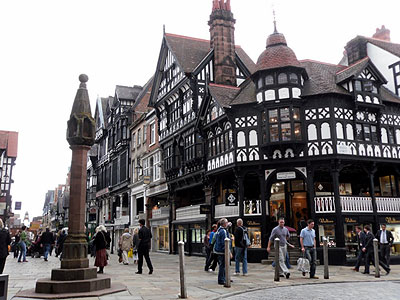
Outside there is a notice warning that the toilets are not suitable for the disabled. (Frank included!) I soon understood why when I set off in search of the said toilets. They are found at the top of two flights of fairly steep stairs, but well worth the journey, for on the way one is treated to snippets of information about the building, as well as a preserved section of wattle and daub wall protected by glass. Amongst the snippets I learned that they are intending to apply for Grade 1 listing, which would make Katie's the only Grade I tea rooms open to the public in the country.
We were both so thirsty by now that we needed long cold drinks, forsaking the search for coffee until later. As the complete circuit of the walls is approximately two miles long, we decided that enough was enough for one day, and anyway it left us with an excuse to return and finish them on another trip.
We wandered along the upper floor of the unique Chester Rows which consist of covered walkways at the first floor, behind which are the entrances to a myriad of shops selling everything the shopaholic can possibly desire. Time was getting on but we still needed that good cup of coffee that had eluded us for so long in Wales. We soon found a well known outlet in the shopping centre and sated our desires, before heading back to the car and Frank's blood tests.
Before I finish I must just pass on this warning to all Welshmen .... A famous archaic bye-law of Chester states that any Welshman loitering within the city walls after sunset may be killed by decapitation or shot with a long bow. The law was originally imposed by Henry V following the Welsh revolt. This order was never repealed, and still officially stands on the statute of this day, although it no longer provides protection against prosecution for murder.
Links for information on this page:
Crown Carveries
Stan's Superstore
Whittington Castle
Llangollen
Ladies of Llangollen
Erddig
An excellent Chester Walls site
